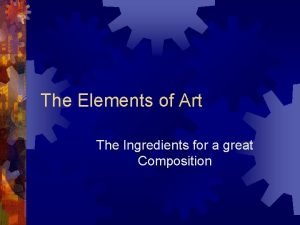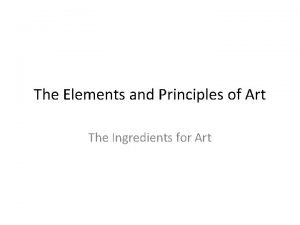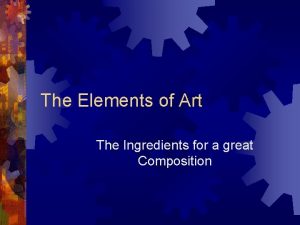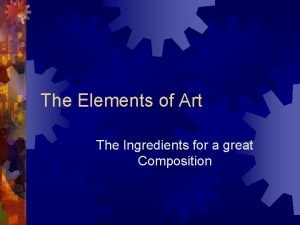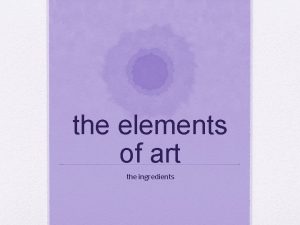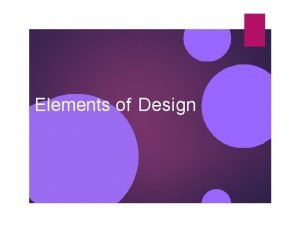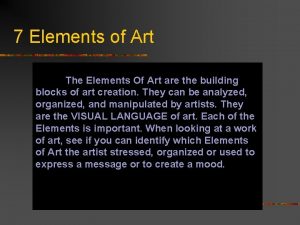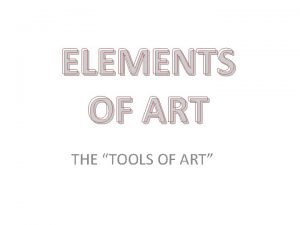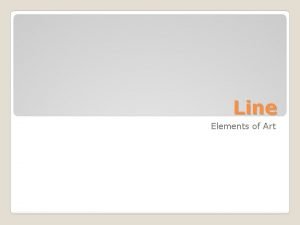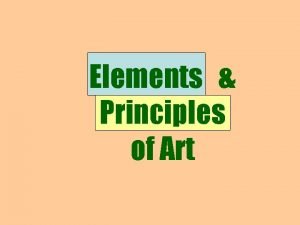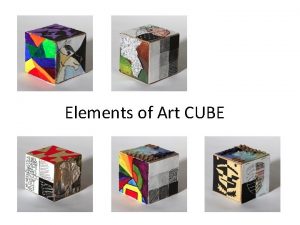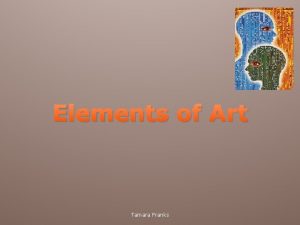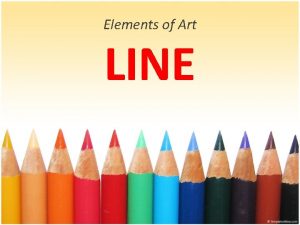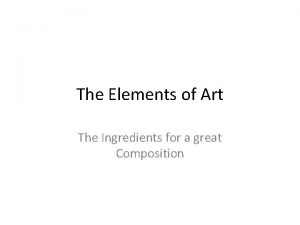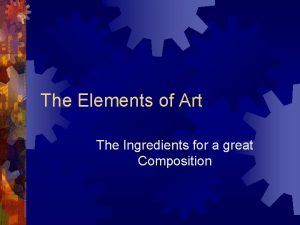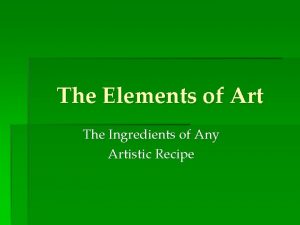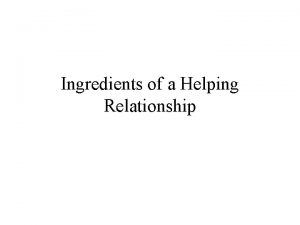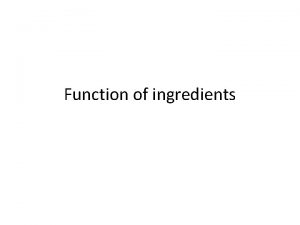The Elements of Art The Ingredients for a
























- Slides: 24

The Elements of Art The Ingredients for a great Composition

What are the elements of art? The Elements of Art are the “tools” that artists use to make art. There are 7 of them: Line Value Texture Shape Form Space Color

Line A line is a path that a point takes through space. Lines can be thick, thin, dotted or solid. They can make straight movements, zig-zags, waves or curls. They may be horizontal vertical diagonal

Horizontal Lines are generally restful, like the horizon, where the sky meets land

Vertical lines seem to be reaching, so they may seem inspirational like tall majestic trees or church steeples

Diagonal lines tend to be disturbing. They suggest decay or chaos like lightening or falling trees

Shape is created when a line becomes connected and encloses space. It is the outline or outward appearance of something. Shapes are 2 Dimensional (2 -D) which means there are 2 ways they can be measured. You can measure its HEIGHT and its WIDTH. There are two basic types of shape.

The 2 types of shape Geometric shapes have smooth even edges and are measurable. The include the square, the circle, the triangle and the rectangle.

Organic shapes have more complicated edges and are usually found in nature. Leaves, flowers, ameba, etc.

Form A Form is a shape that has become 3 Dimensional (3 -D) Form has HEIGHT, WIDTH and DEPTH--which is the 3 rd dimension. Depth shows the thickness of the object. Forms are NOT flat like shapes are!

Value is the lightness or darkness of a color. Value makes objects appear more real because it imitates natural light. When showing value in a work of art, you will need a LIGHT SOURCE. A light source is the place where the light is coming from, the darkest areas are always on the opposite side of the light.

Color There are 3 primary colors: Red, Yellow and Blue These colors are primary for 2 reasons: 1. They can’t be mixed to be made 2. They make all the other colors on the color wheel

Color When you mix 2 primary colors together, you get a secondary color. For example: Red and Yellow=Orange Red and Blue=Violet Yellow and Blue= Green

Color Schemes Color is divided into groups based on the way they are placed on the color wheel: 3 -4 colors “next-door-neighbors” to each other creates an analogous color scheme

Color schemes 2 colors that are directly opposite each other (going across the center) creates a complimentary color scheme

Colors have temperatures Colors can convey emotion and feelings too. Have your ever felt “blue? ” Been “green’ with envy? Called a “yellow” coward? It is important that artists understand the effects of color when they are trying to get the viewers of their art to feel a particular way.

Color Temperatures Warm colors are those that have Reds, Yellows and Oranges. Warm colors seem to advance (or come forward) in an artwork. Cool colors are those that have Blues, Greens and Violets. Cool colors seem to recede (or go back into) an artwork.

Texture is the way the surface of an object actually feels. In the artistic world, we refer to two types of texture---tactile and implied

Space is basically divided into 3 parts: Foreground, Middle Ground and Background Generally, the background area is considered to be the upper 1/3 of the picture plane. The middle ground area is considered to be the middle 1/3 of the picture plane. The foreground area is considered to be the lower 1/3 of the picture plane.

Space can be shallow or deep depending on what the artist wants to use. Shallow space is used when the artist has objects very close to the viewer.

Space Positive space is the actual object(s) within the artwork Negative Space is the area in and around the objects. It is the “background” and it contributes to the work of art---you can’t have positive space without negative space

Space Perspective is also a way of showing space in a work of art. Perspective is when the artist uses a vanishing point on the horizon and then creates a sense of deep space by showing objects getting progressively smaller as they get closer to the vanishing point.

Space Objects may overlap as well. When objects are overlapped it is obvious that enough space had to be in the picture to contain all the objects that have been included

The Elements of Art in Review The Elements of Art are the “tools” that artists use to make art. They are the basic “foundation” of a good composition Line Value Texture Shape Form Space Color
 The ingredients of art
The ingredients of art Ingredients of art
Ingredients of art Generally restful like the horizon where the sky meets land
Generally restful like the horizon where the sky meets land Generally restful like the horizon where the sky
Generally restful like the horizon where the sky Formuö
Formuö Novell typiska drag
Novell typiska drag Tack för att ni lyssnade bild
Tack för att ni lyssnade bild Ekologiskt fotavtryck
Ekologiskt fotavtryck Shingelfrisyren
Shingelfrisyren En lathund för arbete med kontinuitetshantering
En lathund för arbete med kontinuitetshantering Underlag för särskild löneskatt på pensionskostnader
Underlag för särskild löneskatt på pensionskostnader Tidbok för yrkesförare
Tidbok för yrkesförare Sura för anatom
Sura för anatom Densitet vatten
Densitet vatten Datorkunskap för nybörjare
Datorkunskap för nybörjare Tack för att ni lyssnade bild
Tack för att ni lyssnade bild Tes debattartikel
Tes debattartikel För och nackdelar med firo
För och nackdelar med firo Nyckelkompetenser för livslångt lärande
Nyckelkompetenser för livslångt lärande Påbyggnader för flakfordon
Påbyggnader för flakfordon Vätsketryck formel
Vätsketryck formel Publik sektor
Publik sektor Jag har nigit för nymånens skära
Jag har nigit för nymånens skära Presentera för publik crossboss
Presentera för publik crossboss Argument för teckenspråk som minoritetsspråk
Argument för teckenspråk som minoritetsspråk
